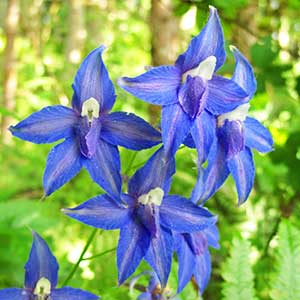Delphinium parryi
Delphinium trolliifolium
Parry's larkspur, San Bernardino larkspur
Columbian larkspur, cow-poison, poison delphinium, poison larkspur
(10-)40-80(-110) cm;
base reddish, puberulent.
(40-)60-120(-180) cm;
base usually reddish, glabrous to puberulent.
blade pentagonal, 1-7 × 2-10 cm, ± puberulent; ultimate lobes 3-27, width 1-20 mm (basal), 0.5-5 mm (cauline).
blade ± pentagonal, 4-8 × 7-16 cm, margins ± incised, nearly glabrous; ultimate lobes 0-9, width 15-30 mm (basal), 5-20 mm (cauline), widest at middle or in proximal 1/2.
(2-)8-24(-48)-flowered, cylindric;
pedicel ± spreading, (0.5-)1-3(-6.8) cm, usually puberulent;
bracteoles 2-7(-16) mm from flowers, green to blue, lance-linear, 2-6(-10) mm, puberulent.
(5-)14-40(-75)-flowered, ± open, at least 2 times longer than wide;
pedicel 1-4(-9) cm, puberulent to glabrous;
bracteoles (2-)6-12 mm from flowers, green, linear, 5-9(-14) mm, puberulent.
sepals dark blue to bluish purple, puberulent, lateral sepals spreading or reflexed, (7-)10-20(-25) × 4-9 mm, spurs straight, ascending 0-30° above horizontal, 9-17(-21) mm;
lower petal blades slightly elevated, ± exposing stamens, 3-10 mm, clefts 2-6 mm;
hairs mostly near base of cleft, centered or on inner lobes, white.
sepals dark blue, glabrous, lateral sepals spreading, (8-)14-21 × 5-9 mm, spurs straight or downcurved at apex, within 20° of horizontal, (10-)16-23 mm;
lower petal blades covering stamens, 5-10 mm, clefts 1.5-3 mm;
hairs sparse, mostly near junction of blade and claw, centered or on inner lobes, well dispersed, yellow.
10-19 mm, 2.8-4 times longer than wide, puberulent or glabrous.
(15-)23-34 mm, 3.8-5.5 times longer than wide, glabrous.
seed coat cells ± brick-shaped, cell margins undulate, surfaces ± roughened.
unwinged;
seed coats smooth.
= 16.
Delphinium parryi
Delphinium trolliifolium
Subspecies 5 (5 in the flora).
A number of local phases are found in Delphinium parryi. Five of these appear consistently distinct and are recognized here. Other phases may be locally distinct but grade into other nearby phases. Delphinium parryi hybridizes with D. cardinale (D. ×inflexum Davidson).
The Kawaiisu used the ground root of Delphinium parryi medicinally as a salve for swollen limbs (D. E. Moerman 1986, no subspecies specified).
(Discussion copyrighted by Flora of North America; reprinted with permission.)
Delphinium trolliifolium occurs in the northern Coast Range of California, the Columbia River Valley to just east of Mt. Hood, and the Willamette Valley of Oregon upstream to Lane County. California plants differ somewhat from Oregon plants in pubescence patterns and habitat preferences. Further study may show that two entities are involved here.
Hybrids between Delphinium trolliifolium and D. decorum, D. menziesii subsp. pallidum (D. ×pavonaceum Ewan, Peacock larkspur), D. nudicaule, D. nuttallianum, and D. nuttallii are known. Delphinium trolliifolium is likely to be confused only with D. bakeri. Refer to discussion under that species for differences.
(Discussion copyrighted by Flora of North America; reprinted with permission.)
1. Basal leaves usually absent at anthesis. | → 2 |
1. Basal leaves usually present at anthesis. | → 3 |
2. Lateral sepals 16–25 mm. | subsp. blochmaniae |
2. Lateral sepals 9–15 mm. | subsp. parryi |
3. Lateral sepals 7–11 mm; above 700 m elevation. | subsp. purpureum |
3. Lateral sepals (9–)12–20 mm; below 700 m elevation. | → 4 |
4. Sepals usually reflexed. | subsp. eastwoodiae |
4. Sepals usually spreading. | subsp. maritimum |


